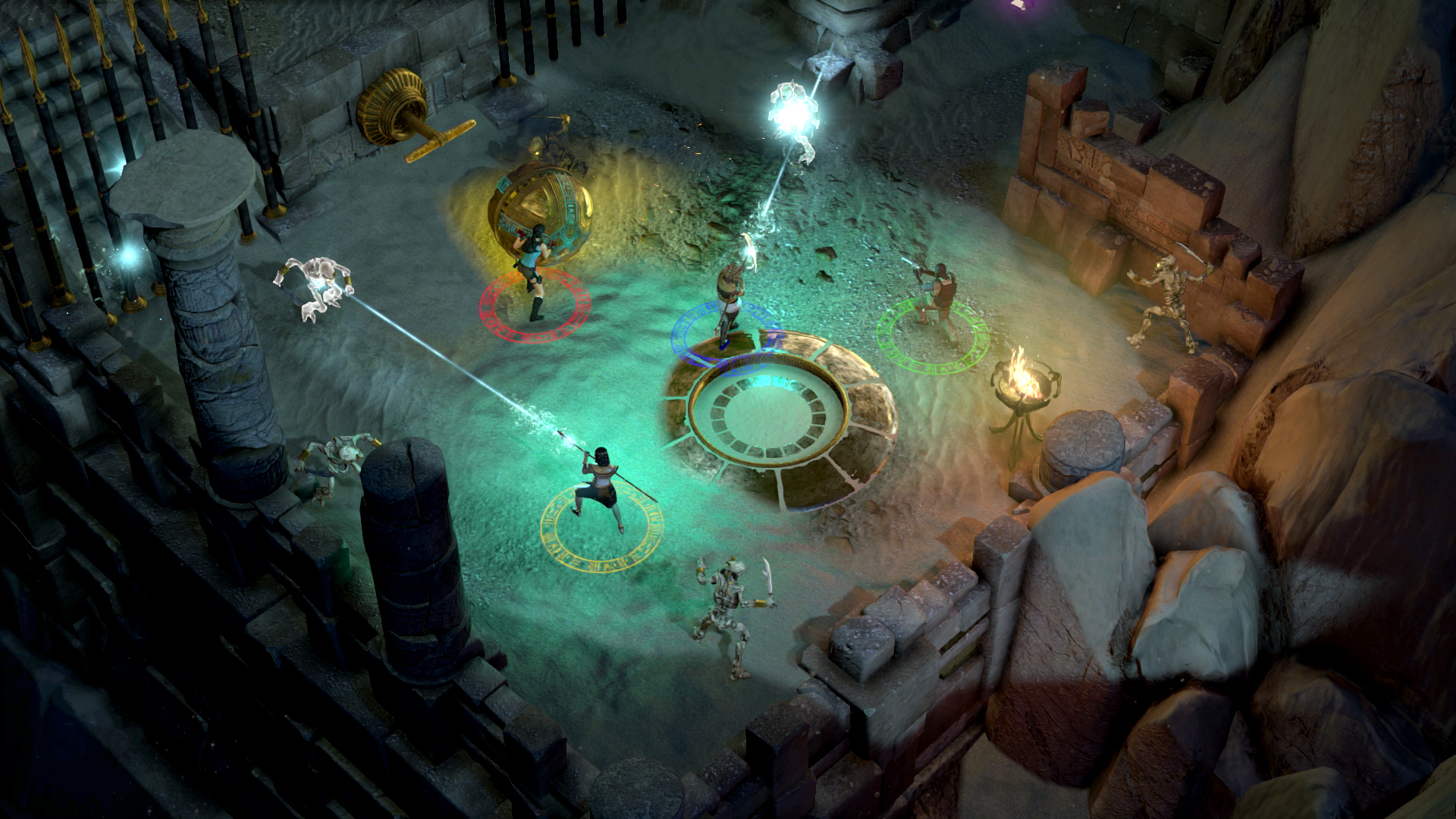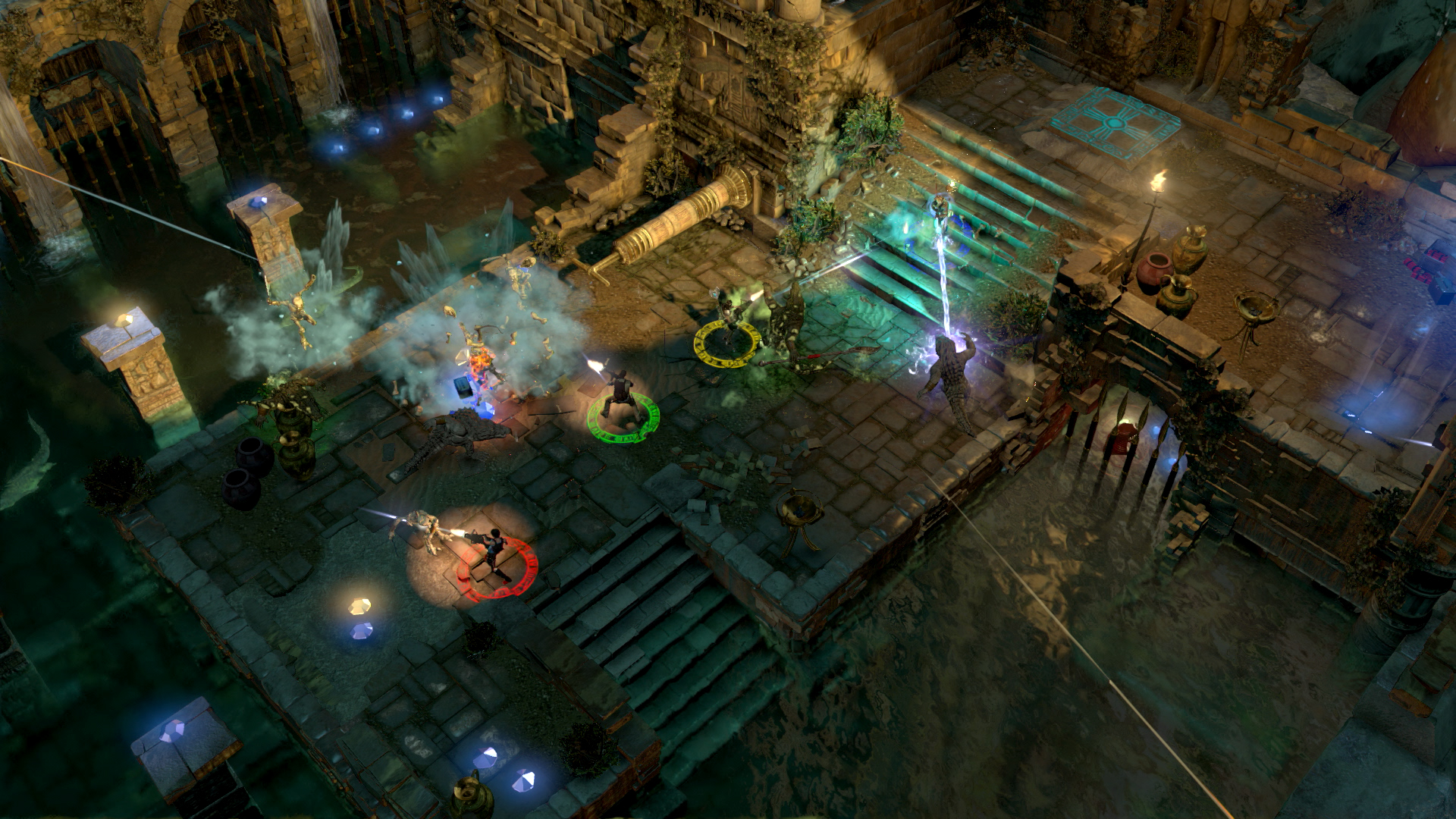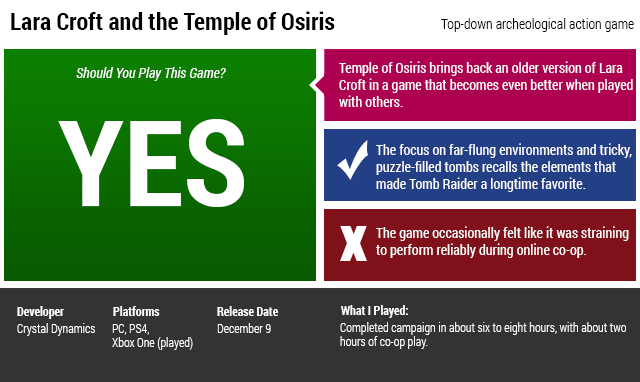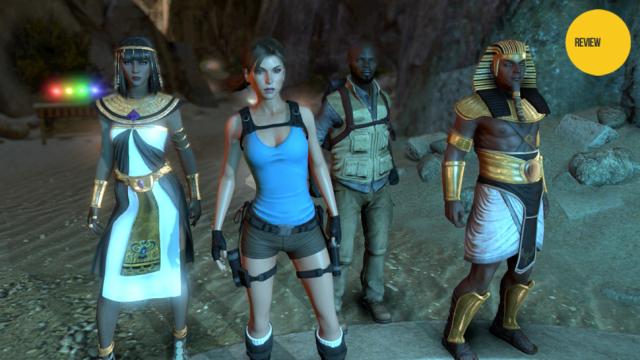She’s always been a shape-shifter, our Lara. Not just in the silhouette shaped by ever-advancing polygon technology, but also in the sorts of games she’s headlined. The newest Lara Croft game moulds her into a form that’s a little bit of both past and present. It works, mostly.
This is the return of the wise-cracking Lara, the one who shrugs off falls and shoots undead enemies with a smirk. The 2013 Tomb Raider reboot — a new origin story with a younger, much more vulnerable Lara — didn’t offer much by way of actual ancient grave pilfering but Lara Croft and the Temple of Osiris is rife with it. In fact, it’s pretty much the whole game.
Like 2010’s Lara Croft and the Guardian of Light, Temple of Osiris harkens back to the first few old-school Tomb Raider games. Lara’s kitted out in her classic garb and her main order of business is to seek out and grab treasures from antiquity. But, as it has in the past, disturbing centuries-old artefacts awakens terrible forces. This time, it’s Egyptian god of darkness Set who gets partially freed from mystical entrapment after Lara and competing explorer Carter Bell remove the Staff of Osiris from its appointed place.
After this grievous mistake — which curses the two mortals and also awakens gods Isis and Horus — Lara and companions must gather up the bodily remains of sun god Osiris so that he can reincarnate and stop Set from doing dark-and-vaguely-evil-things to the Earth.

This newest Lara Croft game presents as good an opportunity as any to think about the various elements that make up the Tomb Raider mystique and attract its different groups of fans. While some get drawn into the plot progression of Lara’s adventures, others might care more about the design aspirations or exotic locations of a particular title. Really difficult puzzles will thrill or annoy different types of players but some people remain fixated on Lara’s relative sexiness vis-à-vis other game protagonists. More than other long-running series, the Tomb Raider games have to walk a tightrope, lest an overabundance of the series’ myriad good ingredients become a problem.
There’s a little bit of overreaching in Temple of Osiris and it left me feeling like the game suffers from trying to do more and winding up with less in a few aspects. Mind you, for the most part, it’s a very fun, good-looking game, one that recreates the charms of its predecessor. Here, players control Lara in isometrically-presented, interlocking environments, engaging in quick-reflex arcade action where stealth never comes into play. Playable characters wield a mix of magical abilities and collectible weapons, along with discoverable amulets and rings that bestow helpful and deleterious characteristics like faster movement and regenerating health. These buffs activate when you rack up kills or collect enough gems. The cutaway view helps the ancient Egyptian oasis and tombs feel vast and an impressive depth-of-field adds a more filmic feel. Blasting away at clumps of skeleton archers, lizardman wizards and giant exploding-kamikaze mummies always feels tense, affirming the decision to put Lara in a different kind of game template. Taking in the action from a god’s-eye-view camera angle makes it feel more epic.

As a single-player experience, Temple of Osiris is a pleasant, middle-of-the-road mix of puzzles and arcade shooting. Not a tough experience by any means. The challenge scales up when more than one player joins the quest to revive Osiris. The celestial characters have special traits that let them create force fields that mortals can stand on, as well as being able to banish portals and elevate mystical platforms. Environmental puzzles scale up according to the number of players and that’s when Temple of Osiris becomes exponentially more enjoyable.
I played a few hours of online co-op with my colleague Kirk Hamilton and we had big fun deciphering who needed to do what in the puzzle-solving sections. ‘Remember, Isis can jump on Lara’s grapple-hook line and walk across it to reach a switch or collectible.’ ‘Oh, right… I can stand behind of your force field so the arrows don’t hit me.’ One puzzle had Kirk using Isis and the Staff of Osiris to shoot through a glowing sphere while my Lara moved mirrors around to bounce the beam of light through other similar spheres. We scratched our heads for a good chunk of time, basking in the accomplishment when we cracked it together. Later, I ran through that same puzzle solo and found a simpler experience in its place.

The threads of competitive co-op that ran through Guardian of Light have been multiplied here. Like the last game, Temple of Osiris tracks which player kills more enemies or grabs more gems. Each tomb area will have reward rooms that hold chests requiring a set number of gems to open them up. The tombs also dole out rewards based on performance and specific actions — knocking five enemies into a pit, for example — so the motivation to co-operate is just as strong as the urge to screw over your partners and grab loot. The multiplayer design elements also show up in the form of combat challenges that offer up a ton of gems. Combat challenge skirmishes spawn multiple waves of increasingly powerful enemies until you beat them all. Community challenges will be part of the mix, too, but weren’t yet live during the pre-release timeframe during which I played.
But, in scaling up the template — in particular, LCTOO‘s multiplayer component — Crystal Dynamics have left players with a slightly shakier iteration of a good formula. I mostly played the game solo and was plagued by the feeling that the aiming of my jumps wasn’t as precise as it needed to be. Kirk echoed that when we teamed up and we both noted that LCTOO came across as a little jittery at times. Sometimes his Isis would pop up all over the screen, evidence of how lag was affecting the transmission of player movement from his machine to mine. The default camera view also feels very zoomed out and we agreed that the screen felt hard to read at more chaotic times.
There’s a bit of a paradox with the naming conventions for the divergent offerings around this iconic heroine. Last year’s game called Tomb Raider had little tomb raiding. The newest games with the words ‘Lara Croft’ in their titles aren’t really about her past or personal maturation in any meaningful way. Yet, when it comes to multiplayer, the last two Lara Croft games win out insofar as implementation. Their team-of-rivals gameplay is far better than the uninspired run-and-gun options that were duct-taped onto 2013 Tomb Raider. It is, however, plagued by some growing pains as it tries to expand what its design is able to do. But, as far as an attempt to pull more than one player into archeological adventure, Temple of Osiris is the better Tomb Raider-descended experience. While her best games have been sharpest as solo experiences, the future of a Lara Croft built to play with friends looks like a promising one.

Comments
6 responses to “Lara Croft And The Temple Of Osiris: The Kotaku Review”
“for the most part, it’s a very fun, good-looking game, one that recreates the charms of its predecessor” SOLD!
I spent 3 days at EB Expo this year. 3 DAYS! of all the games i played i didn’t discover this until the last few hours on the last day. the booth was fairly empty and the stations were available so my Brother and I stepped up to give it a go.
Suffice to say that 2 hours later we were still there on the same Demo stations having perfected the Demo level multiple times we have then taken to bursting into fits of maniacal laughter at the literally hundreds of ways we could troll the shit out of each other in Co-OP. Then we went of the discover that with the physics engine there are plenty of little “mini games” you can play with the environment.
My most favourite of that is a portion where a puzzle involves you rolling 2 large balls into cages to weight them down and continue.
Well you can drop land mines and we discovered that this would throw the balls across the map so we tried to trick shot them into the cages.
Then we moved onto playing a match of ‘Gladiator’ when we realised we could smash each other off the map while pushing the balls.
Suffice to say this Tomb Raider game is PACKED TO THE RIM! with amazing content. a Robust Co-op world. A great story. and its just downright fucking FUN FUN FUN especially when you think outside the box a little and just goof off.
This is the FIRST tomb raider game in idk 10-15 years that i have even given a shit about and its a must buy for anyone who has friends!!!
Kudos to the team who put this game together you have turned a stale and dusty franchise into something great!
GR8 M8 8/8
FYI, this isn’t a tomb raider game technically speaking… #nitpicking 😛 do you see Tomb Raider in the title? 😛
cool game though, played the first couple of levels this morning and enjoyed it… just like I enjoyed Lara Croft and the guardian of light (check this out if you haven’t played it)
So is this game completely unrelated to the 2013 reboot? If so that’s a shame, I’d like to see more games in that style, I enjoyed it a lot more than previous titles.
The sequel to that one is out next year. This is the ‘same’ character but a different series.
Yeah, I understand Tomb Raider has a few different faces lately. My girlfriend and I loved the reboot but neither of us could really get into the previous titles. I’ll wait to see some more reviews and gameplay footage of this one but I’m glad they’re doing a sequel to the reboot too.